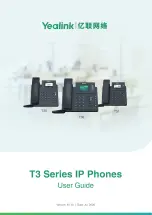
In the absence of TTS, the system uses a coupled two-step procedure to bring the IP phones into
service:
1. H.323 registration
2. TCP socket establishment for call signaling
The TTS feature separates these steps. You can enable IP phones for service with just the
registration step. TCP sockets are established later, as needed.
The TTS feature also changes the direction of socket establishment. With TTS,Communication
Manager, rather than the phone, initiates socket establishment, which further improves
performance. You can enable TTS by default and can also disable TTS for all IP phones in a given
IP network region by changing the IP Network form. TTS does not apply to the following phones:
third party H.323, DCP, BRI, and analog.
The phone can accept an incoming connection request from a server on the gatekeeper list, use
this new connection to replace an existing connection, and continue operation without the need to
reregister. With this mechanism, Communication Manager starts a new connection to each
deskphone during a server interchange. These phones then move quickly to the server and
transition from the standby to active state.
TTS is supported with the following profiles:
• Challenge
• Annex-H
• H.323 signaling over TLS
TTS-TLS is not supported with the following features:
• IPSec VPN – only challenge and Annex-H are supported. H.323 over TLS is not supported
over VPN.
• Unnamed registration
Communication Manager Administration
Related links
on page 73
Administering deskphones on Avaya Aura Communication Manager
on page 78
on page 80
Administering features and CAs for all other IP deskphones
on page 81
Administering your phone
May 2018
Installing and Administering Avaya J169/J179 IP Phone H.323
72
















































